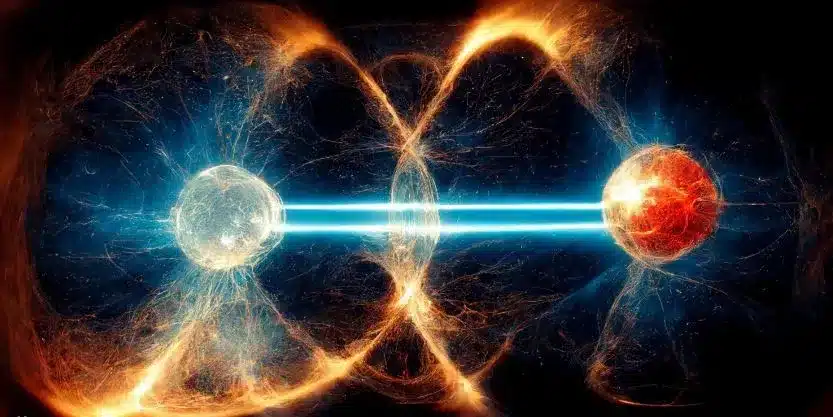About Quantum Nonlocality:
- While classical physics assumes locality, the principle of nonlocality is a feature of many interpretations of quantum mechanics.
- Nonlocality describes the apparent ability of objects to instantaneously know abouteach other’s state, even when separated by large distances (potentially even billions of light years), almost as if the universe at large instantaneously arranges its particles in anticipation of future events.
- Thus, in the quantum world, despitewhat Einsteinhad established about the speed of light being the maximum speed for anything in the universe, instantaneous action or transfer of information does appear to be possible.
- This is in direct contravention of the “principle of locality” (or what Einstein called the “principle of local action”), the ideathat distant objects cannot have direct influence on one another, and that an object is directly influenced only by its immediate surroundings, an idea on which almost all of physics is predicated.
- Nonlocalityoccurs due to the phenomenon of entanglement, whereby particles that interact with each otherbecome permanently correlated, or dependent on each other’s states and properties, to the extent that they effectively lose their individuality and, in many ways, behave as a single entity.
- Nonlocality suggests that the “separate” parts of the universe are actually potentially connected in an intimate and immediate way.
Q1: What are the methods to create Entanglement?
There are several methods such as the Special crystals method, Cooling of the particles method, Nuclear decay and Splitting of an individual photon.Quantum entanglement works on a quantum principle where the quantum state of atomic or subatomic particles are linked in such a way that action performed on one particle will affect another particle separated in space and time.
Last updated on November, 2025
→ Check out the latest UPSC Syllabus 2026 here.
→ Join Vajiram & Ravi’s Interview Guidance Programme for expert help to crack your final UPSC stage.
→ UPSC Mains Result 2025 is now out.
→ UPSC Notification 2026 is scheduled to be released on January 14, 2026.
→ UPSC Calendar 2026 is released on 15th May, 2025.
→ The UPSC Vacancy 2025 were released 1129, out of which 979 were for UPSC CSE and remaining 150 are for UPSC IFoS.
→ UPSC Prelims 2026 will be conducted on 24th May, 2026 & UPSC Mains 2026 will be conducted on 21st August 2026.
→ The UPSC Selection Process is of 3 stages-Prelims, Mains and Interview.
→ UPSC Result 2024 is released with latest UPSC Marksheet 2024. Check Now!
→ UPSC Prelims Result 2025 is out now for the CSE held on 25 May 2025.
→ UPSC Toppers List 2024 is released now. Shakti Dubey is UPSC AIR 1 2024 Topper.
→ UPSC Prelims Question Paper 2025 and Unofficial Prelims Answer Key 2025 are available now.
→ UPSC Mains Question Paper 2025 is out for Essay, GS 1, 2, 3 & GS 4.
→ UPSC Mains Indian Language Question Paper 2025 is now out.
→ UPSC Mains Optional Question Paper 2025 is now out.
→ Also check Best IAS Coaching in Delhi

















